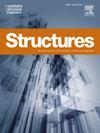Interfacial constitutive model of Fe-SMA-and-steel single-lap-shear bonded joints
IF 4.3
2区 工程技术
Q1 ENGINEERING, CIVIL
引用次数: 0
Abstract
Strengthening in-service steel structures can improve operational performance and extend service life. Employing Fe-based shape memory alloys (Fe-SMA) for proactive reinforcement stands out as a highly satisfactory and safe repair solution. For Fe-SMA-and-steel bonded joints, the load-bearing capacity can reach twice the recovery stresses obtained from activating Fe-SMA. Grounded in the experimental results, the failure process, stress/strain evolution, and force transmission mechanism of bonded joints are analyzed. The loading process of bonded joints before thorough failure undergoes two stages: loading growth and debonding development. In the debonding failure process, the effective bonding length of Fe-SMA-and-steel bonded interfaces, that resists external loads, remains essentially unchanged. Based on 3 types of structural adhesives and 4 types of adhesive thicknesses, the bond-slip constitutive models of bonded interfaces are derived from the experimental bond-slip curves, and the bilinear bond-slip constitutive models, i.e., the triangular cohesive zone models, are established through simplification to facilitate engineering applications. Moreover, the theoretical calculation methods are proposed for the interfacial constitutive parameters. This research provides experimental and interfacial constitutive foundations for the numerical simulation and theoretical calculation of bonded joints, and furthermore offers guidance for practical applications of repairing steel structures by bonding Fe-SMA.
fe - sma -钢单搭剪粘结接头界面本构模型
对在役钢结构进行加固可以提高钢结构的使用性能,延长钢结构的使用寿命。采用铁基形状记忆合金(Fe-SMA)进行主动加固是一种非常令人满意和安全的修复解决方案。对于Fe-SMA-钢结合接头,其承载能力可达到激活Fe-SMA后恢复应力的2倍。根据试验结果,分析了粘结接头的破坏过程、应力应变演化和力传递机理。粘结接头在完全破坏前的加载过程经历了加载增长和脱粘发展两个阶段。在脱粘破坏过程中,fe - sma与钢结合界面的有效粘接长度基本保持不变。基于3种结构胶粘剂和4种胶粘剂厚度,从实验黏结-滑移曲线推导出黏结界面的黏结-滑移本构模型,并通过简化建立双线性黏结-滑移本构模型,即三角黏结区模型,便于工程应用。并提出了界面本构参数的理论计算方法。本研究为粘结接头的数值模拟和理论计算提供了实验和界面本构基础,并为Fe-SMA粘结修复钢结构的实际应用提供了指导。
本文章由计算机程序翻译,如有差异,请以英文原文为准。
求助全文
约1分钟内获得全文
求助全文
来源期刊

Structures
Engineering-Architecture
CiteScore
5.70
自引率
17.10%
发文量
1187
期刊介绍:
Structures aims to publish internationally-leading research across the full breadth of structural engineering. Papers for Structures are particularly welcome in which high-quality research will benefit from wide readership of academics and practitioners such that not only high citation rates but also tangible industrial-related pathways to impact are achieved.
 求助内容:
求助内容: 应助结果提醒方式:
应助结果提醒方式:


